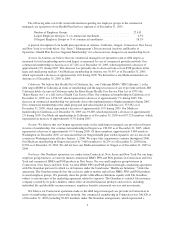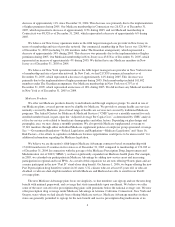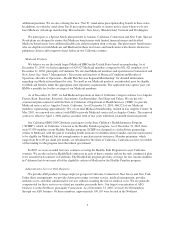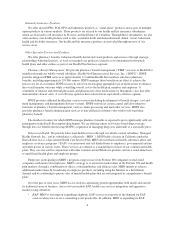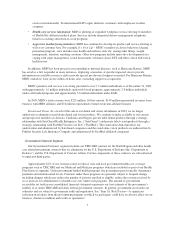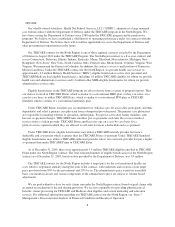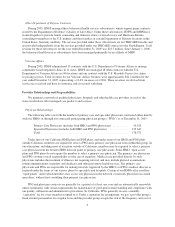Health Net 2005 Annual Report Download - page 15
Download and view the complete annual report
Please find page 15 of the 2005 Health Net annual report below. You can navigate through the pages in the report by either clicking on the pages listed below, or by using the keyword search tool below to find specific information within the annual report.developing market capabilities ahead of the claim components of Health Net One. The new medical management
system was implemented in the Northeast and Arizona health plans for case management functionality in 2005.
As a result, the conversion of the California and Oregon provider and pricing, customer service, medical
management and data warehouse systems was rescheduled for 2006. Additionally, the claims functionality to
support the conversion of the California and Oregon claims processing is scheduled to be completed in 2006 with
the conversion of new business to the Health Net One system in 2007 and the conversion of existing business in
2008. We believe that completion of the Health Net One systems consolidation project will improve customer/
client service and communication, enhance our national product capabilities, realize operational and cost
efficiencies and improve our decision-making capability. In addition, we believe that completion of the project
will enable us to improve our claims turnaround time, auto adjudication rates, electronic data interchange and
Internet capabilities. However, there are risks associated with the Health Net One systems consolidation project.
See “Item 1A. Risk Factors—Any failure to effectively maintain our management information systems could
adversely affect our business.”
Consumer-Directed Health Care Plans; Health Savings Accounts
Health Savings Accounts (“HSAs”) were created in 2003 as part of the MMA. HSAs are individually owned
accounts, similar to an IRA or a 401(k) retirement plan, that generally allow employees to make contributions to
the account on a pretax basis. Funds in HSAs can be used to pay for certain qualified medical expenses such as
plan deductibles, copayments and coinsurance on a tax-free basis. HSA funds can be invested and earnings on the
investments are generally tax-free. HSAs must be used in conjunction with high-deductible health plans. High-
deductible health plans provide in-and out-of-network benefits and cover a wide range of health care services.
During 2005, our Northeast and Arizona health plans launched HSA programs. Our HSA programs and
other consumer-driven health care products provide our members with tools to determine what health care
services they may need and to estimate how much those services would cost. We support our HSA programs with
a web-based program that assists members in educating themselves about health care. The web-based program
includes Decision Power and prescription drug and hospital comparison tools. In 2006, we expect to further
enhance our consumer-driven health care initiative by offering the HSA program in California and Oregon and
expect to launch the Health Net Health Reimbursement Account, commonly referred to as an HRA. See
“Item 1A. Risk Factors—Our efforts to capitalize on business opportunities provided by consumer-directed
healthcare, such as our HSA program, could prove to be unsuccessful.”
Medical Management
We believe that managing health care costs is an essential function for a managed care company. Among the
medical management techniques we utilize to contain the growth of health care costs are pre-authorization or
certification for outpatient and inpatient hospitalizations and a concurrent review of active inpatient hospital stays
and discharge planning. We believe that this authorization process reduces inappropriate use of medical
resources and achieves efficiencies in cases where reimbursement is based on risk-sharing arrangements. We also
contract with third parties to manage certain conditions such as neonatal intensive care unit admissions and stays,
as well as chronic conditions such as asthma, diabetes and congestive heart failure. These techniques are widely
used in the managed care industry and are accepted practice in the medical profession. In 2005, we saw steady
improvement in our initiatives, especially in the Northeast and California. Our strengthened medical management
practices helped lower commercial health care cost trends. For example, our more focused inpatient review
processes caused commercial hospital bed days per thousand commercial enrollees to drop from 224 in the first
quarter of 2005 to 205 in the fourth quarter of 2005. We believe that the reduced number of commercial bed days
reflect our more effective use of population-based data analysis and increasingly refined identification of
members with conditions whose care we can improve by providing them with education and support. We are
investing in enterprise-wide analytic capabilities to more precisely deploy the appropriate resources to members
who can benefit from our services.
13


